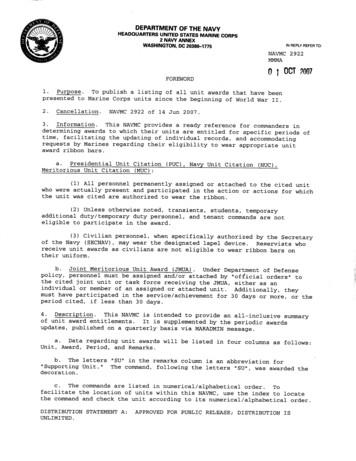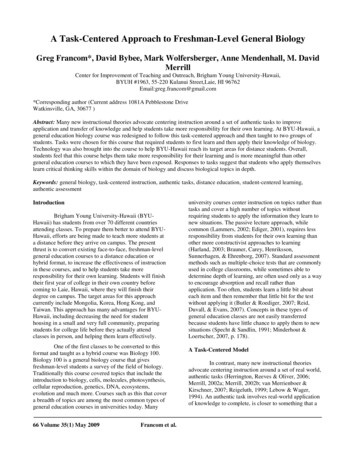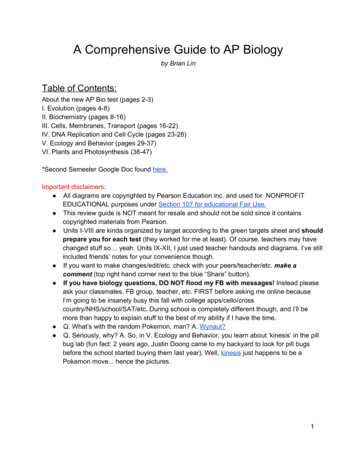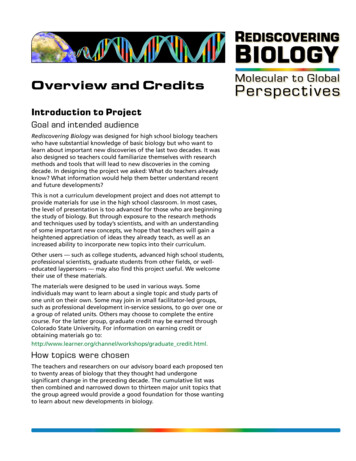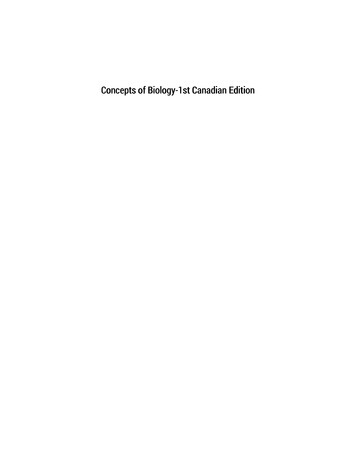
Transcription
Concepts of Biology-1st Canadian Edition
Concepts of Biology-1st Canadian EditionCHARLES MOLNAR AND JANE GAIRSamantha Fowler, Rebecca Roush, James Wise, Yael Avissar, Jung Choi, Jean DeSaix, Vladimir Jurukovski, RobertWise, Connie Rye, OpenStax College
Concepts of Biology-1st Canadian Edition by Charles Molnar and Jane Gair is licensed under a Creative Commons Attribution 4.0International License, except where otherwise noted.Unless otherwise noted, Concepts of Biology is 2013 Rice University. The textbook content was produced by OpenStax College and islicensed under a Creative Commons Attribution 4.0 Unported License. This book is a modified version of Concepts of Biology.Modifications to the book were made by Charles Molnar and Jane Gair, and include:1. Remixed Concepts of Biology from 6 units into 4 units.2. Removed the original Unit 4: Evolution and the Diversity of Life from Concepts of Biology.3. Remixed the original Unit 5: Animal Structure and Function from Concepts of Biology by embeddingChapters 33-43 from Biology by OpenStax College.4. Adapted PowerPoints for each chapter- includes additional notes, images, and embedded videos.5. Added resources from “Let’s Talk Science” to the end of each PowerPoint.Under the terms of the CC-BY license, you are free to copy, redistribute, modify or adapt this book as long as you provide attribution.Additionally, if you redistribute this textbook, in whole or in part, in either a print or digital format, then you must retain on every physicaland/or electronic page the following attribution:Download this book for free at http://open.bccampus.caFor questions regarding this license, please contact opentext@bccampus.ca. To learn more about the B.C. Open Textbook project, visithttp://open.bccampus.caCover Image: Molecule Display 298/) by net efekt (https://www.flickr.com/photos/wheatfields/) used under a CC-BY-license (https://creativecommons.org/licenses/by/2.0/)
ContentsAbout the BookviPreface to the original textbook, by OpenStax CollegeviiPreface to the 1st Canadian EditionxiiUnit 1. The Cellular Foundation of LifeChapter 1: Introduction to Biology1.1 Themes and Concepts of Biology1.2 The Process of ScienceChapter 1 PowerPointChapter 2: Introduction to the Chemistry of Life2.1 The Building Blocks of Molecules2.2 Water2.3 Biological MoleculesChapter 2 PowerPoint2321353637495878Unit 4: Animal Structure and FunctionVersioning History80
About the BookConcepts of Biology—1st Canadian Edition has been adapted by Charles Molnar and Jane Gair from the OpenStaxCollege textbook, Concepts of Biology. For information about what was changed in this adaptation, refer to thecopyright statement at the bottom of the home page. This adaptation is a part of the B.C. Open Textbook project.The B.C. Open Textbook Project began in 2012 with the goal of making postsecondary education in BritishColumbia more accessible by reducing student cost through the use of openly licensed textbooks. The BC OpenTextbook Project is administered by BCcampus and funded by the British Columbia Ministry of AdvancedEducation.Open textbooks are open educational resources (OER); they are instructional resources created and shared inways so that more people have access to them. This is a different model than traditionally copyrighted materials.OER are defined as teaching, learning, and research resources that reside in the public domain or have beenreleased under an intellectual property license that permits their free use and re-purposing by others (HewlettFoundation). Our open textbooks are openly licensed using a Creative Commons license, and are offered invarious e-book formats free of charge, or as printed books that are available at cost. For more informationabout this project, please contact opentext@bccampus.ca. If you are an instructor who is using this book for acourse, please let us know.vi
Preface to the original textbook, by OpenStax CollegeConcepts of Biology is intended for the introductory biology course for non-science majors taught at most twoand four-year colleges. The scope, sequence, and level of the program are designed to match typical coursesyllabi. This text includes interesting features that make connections between scientific concepts and theeveryday world of students. Concepts of Biology conveys the major themes of biology, such as a foundation inevolution, and features a rich and engaging art program.Welcome to Concepts of Biology, an OpenStax College resource. This textbook has been created with severalgoals in mind: accessibility, customization, and student engagement—all while encouraging students towardhigh levels of academic scholarship. Instructors and students alike will find that this textbook offers a strongintroduction to biology in an accessible format.About OpenStax CollegeOpenStax College is a non-profit organization committed to improving student access to quality learningmaterials. Our free textbooks are developed and peer-reviewed by educators to ensure they are readable, accurate,and meet the scope and sequence requirements of today’s college courses. Unlike traditional textbooks, OpenStaxCollege resources live online and are owned by the community of educators using them. Through our partnershipswith companies and foundations committed to reducing costs for students, OpenStax College is working toimprove access to higher education for all. OpenStax College is an initiative of Rice University and is madepossible through the generous support of several philanthropic foundations.About OpenStax College’s ResourcesOpenStax College resources provide quality academic instruction. Three key features set our materials apart fromothers: they can be customized by instructors for each class, they are a “living” resource that grows online throughcontributions from science educators, and they are available free or for minimal cost.CustomizationOpenStax College learning resources are designed to be customized for each course. Our textbooks provide asolid foundation on which instructors can build, and our resources are conceived and written with flexibility invii
viii CONCEPTS OF BIOLOGY-1ST CANADIAN EDITIONmind. Instructors can select the sections most relevant to their curricula and create a textbook that speaks directlyto the needs of their classes and student body. Teachers are encouraged to expand on existing examples by addingunique context via geographically localized applications and topical connections.Concepts of Biology can be easily customized using our online platform. Simply select the content most relevantto your syllabus and create a textbook that speaks directly to the needs of your class. Concepts of Biology isorganized as a collection of sections that can be rearranged, modified, and enhanced through localized examplesor to incorporate a specific theme of your course. This customization feature will help bring biology to life foryour students and will ensure that your textbook truly reflects the goals of your course.CurationTo broaden access and encourage community curation, Concepts of Biology is “open source” licensed undera Creative Commons Attribution (CC-BY) license. The scientific community is invited to submit examples,emerging research, and other feedback to enhance and strengthen the material and keep it current and relevant fortoday’s students. Submit your suggestions to info@openstaxcollege.org, and check in on edition status, alternateversions, errata, and news on the StaxDash at http://openstaxcollege.org.CostOur textbooks are available for free online, and in low-cost print and e-book editions.About Concepts of BiologyConcepts of Biology is designed for the single-semester introduction to biology course for non-science majors,which for many students is their only college-level science course. As such, this course represents an importantopportunity for students to develop the necessary knowledge, tools, and skills to make informed decisions as theycontinue with their lives. Rather than being mired down with facts and vocabulary, the typical non-science majorstudent needs information presented in a way that is easy to read and understand. Even more importantly, thecontent should be meaningful. Students do much better when they understand why biology is relevant to theireveryday lives. For these reasons, Concepts of Biology is grounded on an evolutionary basis and includes excitingfeatures that highlight careers in the biological sciences and everyday applications of the concepts at hand. Wealso strive to show the interconnectedness of topics within this extremely broad discipline. In order to meet theneeds of today’s instructors and students, we maintain the overall organization and coverage found in most syllabifor this course. A strength of Concepts of Biology is that instructors can customize the book, adapting it to theapproach that works best in their classroom. Concepts of Biology also includes an innovative art program thatincorporates critical thinking and clicker questions to help students understand—and apply—key concepts.Coverage and ScopeOur Concepts of Biology textbook adheres to the scope and sequence of most one-semester non-majors coursesnationwide. We also strive to make biology, as a discipline, interesting and accessible to students. In additionto a comprehensive coverage of core concepts and foundational research, we have incorporated features that
PREFACE TO THE ORIGINAL TEXTBOOK, BY OPENSTAX COLLEGE ixdraw learners into the discipline in meaningful ways. Our scope of content was developed after surveying over ahundred biology professors and listening to their coverage needs. We provide a thorough treatment of biology’sfundamental concepts with a scope that is manageable for instructors and students alike. Unit 1: The Cellular Foundation of Life. Our opening unit introduces students to the sciences, includingthe process of science and the underlying concepts from the physical sciences that provide a frameworkwithin which learners comprehend biological processes. Additionally, students will gain solidunderstanding of the structures, functions, and processes of the most basic unit of life: the cell. Unit 2: Cell Division and Genetics. Our genetics unit takes learners from the foundations of cellularreproduction to the experiments that revealed the basis of genetics and laws of inheritance. Unit 3: Molecular Biology and Biotechnology. Students will learn the intricacies of DNA, proteinsynthesis, and gene regulation and current applications of biotechnology and genomics. Unit 4: Evolution and the Diversity of Life. The core concepts of evolution are discussed in this unit withexamples illustrating evolutionary processes. Additionally, the evolutionary basis of biology reappearsthroughout the textbook in general discussion and is reinforced through special call-out featureshighlighting specific evolution-based topics. The diversity of life is explored with detailed study of variousorganisms and discussion of emerging phylogenetic relationships between and among bacteria, protistkingdoms, fungi, plants, and animals. Unit 5: Animal Structure and Function. An introduction to the form and function of the animal body isfollowed by chapters on the immune system and animal development. This unit touches on the biology ofall organisms while maintaining an engaging focus on human anatomy and physiology that helps studentsconnect to the topics. Unit 6: Ecology. Ecological concepts are broadly covered in this unit, with features highlighting localized,real-world issues of conservation and biodiversity.Pedagogical Foundation and FeaturesBecause of the impact science has on students and society, an important goal of science education is to achieve ascientifically literate population that consistently makes informed decisions. Scientific literacy transcends a basicunderstanding of scientific principles and processes to include the ability to make sense of the myriad instanceswhere people encounter science in day-to-day life. Thus, a scientifically literate person is one who uses sciencecontent knowledge to make informed decisions, either personally or socially, about topics or issues that have aconnection with science. Concepts of Biology is grounded on a solid scientific base and designed to promotescientific literacy. Throughout the text, you will find features that engage the students in scientific inquiry bytaking selected topics a step further. Evolution in Action features uphold the importance of evolution to all biological study through discussionslike “Global Decline of Coral Reefs” and “The Red Queen Hypothesis.” Career in Action features present information on a variety of careers in the biological sciences, introducingstudents to the educational requirements and day-to-day work life of a variety of professions, such asforensic scientists, registered dietitians, and biogeographers.
x CONCEPTS OF BIOLOGY-1ST CANADIAN EDITION Biology in Action features tie biological concepts to emerging issues and discuss science in terms ofeveryday life. Topics include “Invasive Species” and “Photosynthesis at the Grocery Store.”Art and Animations that EngageOur art program takes a straightforward approach designed to help students learn the concepts of biology throughsimple, effective illustrations, photos, and micrographs. Concepts of Biology also incorporates links to relevantanimations and interactive exercises that help bring biology to life for students. Concepts in Action features direct students to online interactive exercises and animations to add a fullercontext and examples to core content.About Our TeamConcepts of Biology would not be possible if not for the tremendous contributions of the authors and communityreviewing teamSenior ContributorsSamantha Fowler Clayton State UniversityRebecca RoushSandhills Community CollegeJames WiseHampton University
PREFACE TO THE ORIGINAL TEXTBOOK, BY OPENSTAX COLLEGE xiFaculty Contributors and ReviewersMark BelkBrigham Young UniversityLisa BoggsSouthwestern Oklahoma State UniversitySherryl Broverman Duke UniversityDavid ByresFlorida State College at JacksonvilleAaron CassillThe University of Texas at San AntonioKaren ChampCollege of Central FloridaSue ChaplinUniversity of St. ThomasDiane DayClayton State UniversityJean DeSaixUniversity of North Carolina at Chapel HillDavid HunnicuttSt. Norbert CollegeBarbara KuehnerHawaii Community CollegeBrenda LeadyUniversity of ToledoBernie MarcusGenesee Community CollegeFlora MhlangaLipscomb UniversityMadeline Mignone Dominican CollegeElizabeth NashLong Beach City CollegeMark NewtonSan Jose City CollegeDiana OliverasUniversity of Colorado BoulderAnn PatersonWilliams Baptist CollegeJoel PiperbergMillersville UniversityNick ReevesMt. San Jacinto CollegeAnn ReisenauerSan Jose State UniversityLynn RumfeltGordon CollegeMichael RutledgeMiddle Tennessee State UniversityEdward SaiffRamapo College of New JerseyBrian ShmaefskyKingwood CollegeGary ShultzMarshall UniversityDonald SlishSUNY PlattsburghAnh-Hue TuGeorgia Southwestern State UniversityElena ZoubinaBridgewater State University
Preface to the 1st Canadian EditionPreface to the 1st Canadian Edition, by Charles Molnar and Jane Gair, adapters of Concepts of BiologyIn this survey text, directed at those not majoring in biology, we dispel the assumption that a little learning is adangerous thing. We hope that by skimming the surface of a very deep subject, biology, we may inspire you todrink more deeply and make more informed choices relating to your health, the environment, politics, and thegreatest subject that all of us are entwined in, life itself.In the adapted textbook, Concepts of Biology — 1st Canadian Edition, you will find the following units: Unit 1: The Cellular Foundation of Life Unit 2: Cell Division and Genetics Unit 3: Molecular Biology and Biotechnology Unit 4: Animal Structure and FunctionAdaptations to the original textbook Concepts of Biology by OpenStax College include: Remixed Concepts of Biology from 6 units into 4 units. Removed the original Unit 4: Evolution and the Diversity of Life from Concepts of Biology. Remixed the original Unit 5: Animal Structure and Function from Concepts of Biology by embeddingChapters 33-43 from Biology by OpenStax College. Adapted PowerPoints for each chapter- includes additional notes, images, and embedded videos. Added resources from “Let’s Talk Science” to the end of each PowerPoint.Thanks to BCcampus and Camosun College for funding and support. We are most grateful to the Let’s TalkScience organization from their trove of science links.xii
Unit 1. The Cellular Foundation of Life1
Chapter 1: Introduction to BiologyFigure 1.1 This NASA image is a composite of several satellite-based views of Earth.To make the whole-Earth image, NASA scientists combine observations of differentparts of the planet. (credit: modification of work by NASA)Viewed from space, Earth offers few clues about the diversity of life forms that reside there. The first formsof life on Earth are thought to have been microorganisms that existed for billions of years before plants andanimals appeared. The mammals, birds, and flowers so familiar to us are all relatively recent, originating 130 to200 million years ago. Humans have inhabited this planet for only the last 2.5 million years, and only in the last200,000 years have humans started looking like we do today.2
1.1 Themes and Concepts of BiologyLearning ObjectivesBy the end of this section, you will be able to: Identify and describe the properties of life Describe the levels of organization among living things List examples of different sub disciplines in biologyhttps://www.youtube.com/watch?v 65RRMUrC9mc&list PLi8sJ5jarQsyUiIn4rUA71ecODy3o9Md5&index 73
4 CONCEPTS OF BIOLOGY-1ST CANADIAN EDITIONhttps://www.youtube.com/watch?v P ywN7IQ BA&list PLi8sJ5jarQsyUiIn4rUA71ecODy3o9Md5&index 9Biology is the science that studies life. What exactly is life? This may sound like a silly question with an obviousanswer, but it is not easy to define life. For example, a branch of biology called virology studies viruses, whichexhibit some of the characteristics of living entities but lack others. It turns out that although viruses can attackliving organisms, cause diseases, and even reproduce, they do not meet the criteria that biologists use to definelife.From its earliest beginnings, biology has wrestled with four questions: What are the shared properties that makesomething “alive”? How do those various living things function? When faced with the remarkable diversity of life,how do we organize the different kinds of organisms so that we can better understand them? And, finally—whatbiologists ultimately seek to understand—how did this diversity arise and how is it continuing? As new organismsare discovered every day, biologists continue to seek answers to these and other questions.Properties of LifeAll groups of living organisms share several key characteristics or functions: order, sensitivity or response tostimuli, reproduction, adaptation, growth and development, regulation, homeostasis, and energy processing. Whenviewed together, these eight characteristics serve to define life.OrderOrganisms are highly organized structures that consist of one or more cells. Even very simple, single-celledorganisms are remarkably complex. Inside each cell, atoms make up molecules. These in turn make up cellcomponents or organelles. Multicellular organisms, which may consist of millions of individual cells, have anadvantage over single-celled organisms in that their cells can be specialized to perform specific functions, andeven sacrificed in certain situations for the good of the organism as a whole. How these specialized cells come
1.1 THEMES AND CONCEPTS OF BIOLOGY 5together to form organs such as the heart, lung, or skin in organisms like the toad shown in Figure 1. 2 will bediscussed later.Figure 1.2 A toad represents a highly organized structure consisting of cells, tissues,organs, and organ systems. (credit: “Ivengo(RUS)”/Wikimedia Commons)Sensitivity or Response to StimuliOrganisms respond to diverse stimuli. For example, plants can bend toward a source of light or respond to touch.Even tiny bacteria can move toward or away from chemicals (a process called chemotaxis) or light (phototaxis).Movement toward a stimulus is considered a positive response, while movement away from a stimulus isconsidered a negative response.
6 CONCEPTS OF BIOLOGY-1ST CANADIAN EDITIONFigure 1.3 The leaves of this sensitive plant (Mimosa pudica) will instantly droop andfold when touched. After a few minutes, the plant returns to its normal state. (credit:Alex Lomas)Concept in ActionWatch this video to see how the sensitive plant responds to a touch stimulus.ReproductionSingle-celled organisms reproduce by first duplicating their DNA, which is the genetic material, and then dividingit equally as the cell prepares to divide to form two new cells. Many multicellular organisms (those made up ofmore than one cell) produce specialized reproductive cells that will form new individuals. When reproductionoccurs, DNA containing genes is passed along to an organism’s offspring. These genes are the reason that theoffspring will belong to the same species and will have characteristics similar to the parent, such as fur color andblood type.
1.1 THEMES AND CONCEPTS OF BIOLOGY 7AdaptationAll living organisms exhibit a “fit” to their environment. Biologists refer to this fit as adaptation and it isa consequence of evolution by natural selection, which operates in every lineage of reproducing organisms.Examples of adaptations are diverse and unique, from heat-resistant Archaea that live in boiling hot springsto the tongue length of a nectar-feeding moth that matches the size of the flower from which it feeds. Alladaptations enhance the reproductive potential of the individual exhibiting them, including their ability to surviveto reproduce. Adaptations are not constant. As an environment changes, natural selection causes the characteristicsof the individuals in a population to track those changes.Growth and DevelopmentOrganisms grow and develop according to specific instructions coded for by their genes. These genes provideinstructions that will direct cellular growth and development, ensuring that a species’ young will grow up toexhibit many of the same characteristics as its parents.Figure 1.4 Although no two look alike, these kittens have inherited genes from bothparents and share many of the same characteristics. (credit: Pieter & Renée Lanser)RegulationEven the smallest organisms are complex and require multiple regulatory mechanisms to coordinate internalfunctions, such as the transport of nutrients, response to stimuli, and coping with environmental stresses. Forexample, organ systems such as the digestive or circulatory systems perform specific functions like carryingoxygen throughout the body, removing wastes, delivering nutrients to every cell, and cooling the body.
8 CONCEPTS OF BIOLOGY-1ST CANADIAN EDITIONHomeostasisTo function properly, cells require appropriate conditions such as proper temperature, pH, and concentrations ofdiverse chemicals. These conditions may, however, change from one moment to the next. Organisms are able tomaintain internal conditions within a narrow range almost constantly, despite environmental changes, through aprocess called homeostasis or “steady state”—the ability of an organism to maintain constant internal conditions.For example, many organisms regulate their body temperature in a process known as thermoregulation. Organismsthat live in cold climates, such as the polar bear, have body structures that help them withstand low temperaturesand conserve body heat. In hot climates, organisms have methods (such as perspiration in humans or panting indogs) that help them to shed excess body heat.Figure 1.5 Polar bears and other mammals living in ice-covered regions maintain theirbody temperature by generating heat and reducing heat loss through thick fur and adense layer of fat under their skin. (credit: “longhorndave”/Flickr)Energy ProcessingAll organisms (such as the California condor shown in Figure 1.6) use a source of energy for their metabolicactivities. Some organisms capture energy from the sun and convert it into chemical energy in food; others usechemical energy from molecules they take in.
1.1 THEMES AND CONCEPTS OF BIOLOGY 9Figure 1.6 A lot of energy is required for a California condor to fly.Chemical energy derived from food is used to power flight. Californiacondors are an endangered species; scientists have strived to place awing tag on each bird to help them identify and locate each individualbird. (credit: Pacific Southwest Region U.S. Fish and Wildlife)Levels of Organization of Living ThingsLiving things are highly organized and structured, following a hierarchy on a scale from small to large. The atomis the smallest and most fundamental unit of matter. It consists of a nucleus surrounded by electrons. Atoms formmolecules. A molecule is a chemical structure consisting of at least two atoms held together by a chemical bond.Many molecules that are biologically important are macromolecules, large molecules that are typically formedby combining smaller units called monomers. An example of a macromolecule is deoxyribonucleic acid (DNA),which contains the instructions for the functioning of the organism that contains it.
10 CONCEPTS OF BIOLOGY-1ST CANADIAN EDITIONFigure 1.7 A molecule, like this large DNAmolecule, is composed of atoms. (credit:“Brian0918″/Wikimedia Commons)Concept in ActionTo see an animation of this DNA molecule, click here.Some cells contain aggregates of macromolecules surrounded by membranes; these are called organelles.Organelles are small structures that exist within cells and perform specialized functions. All living things aremade of cells; the cell itself is the smallest fundamental unit of structure and function in living organisms. (Thisrequirement is why viruses are not considered living: they are not made of cells. To make new viruses, they haveto invade and hijack a living cell; only then can they obtain the materials they need to reproduce.) Some organismsconsist of a single cell and others are multicellular. Cells are classified as prokaryotic or eukaryotic. Prokaryotes
1.1 THEMES AND CONCEPTS OF BIOLOGY 11are single-celled organisms that lack organelles surrounded by a membrane and do not have nuclei surrounded bynuclear membranes; in contrast, the cells of eukaryotes do have membrane-bound organelles and nuclei.In most multicellular organisms, cells combine to make tissues, which are groups of similar cells carrying outthe same function. Organs are collections of tissues grouped together based on a common function. Organs arepresent not only in animals but also in plants. An organ system is a higher level of organization that consists offunctionally related organs. For example vertebrate animals have many organ systems, such as the circulatorysystem that transports blood throughout the body and to and from the lungs; it includes organs such as the heartand blood vessels. Organisms are individual living entities. For example, each tree in a forest is an organism.Single-celled prokaryotes and single-celled eukaryotes are also considered organisms and are typically referred toas microorganisms.
12 CONCEPTS OF BIOLOGY-1ST CANADIAN EDITIONFigure 1.8 From an atom to the entire Earth,biology examines all aspects of life. (credit“molecule”: modification of work by JaneWhitney; credit “organelles”: modification ofwork by Louisa Howard; credit “cells”:modification of work by Bruce Wetzel, HarrySchaefer, National Cancer Institute; credit“tissue”: modification of work by“Kilbad”/Wikimedia Commons; credit“organs”: modification of work by MarianaRuiz Villareal, Joaquim Alves Gaspar; credit“organisms”: modification of work by PeterDutton; credit “ecosystem”: modification ofwork by “gigi4791″/Flickr; credit“biosphere”: modification of work by NASA)Which of the following statements is false?
1.1 THEMES AND CONCEPTS OF BIOLOGY 131. Tissues exist within organs which exist within organ systems.2. Communities exist within populations which exist within ecosystems.3. Organelles exist within cells which exist within tissues.4. Communities exist within ecosystems which exist in the biosphere.All the individuals of a species living within a specific area are collectively called a population. For example, aforest may include many white pine trees. All of these pine trees represent the population of white pine trees inthis forest. Different populations may live in the same specific area. For example, the forest with the pine treesincludes populations of flowering plants and also insects and microbial populations. A community is the set ofpopulations inhabiting a particular area. For instance, all of the trees, flowers, insects, and other populations ina forest form the forest’s community. The forest itself is an ecosystem. An ecosystem consists of all the livingthings in a particular area together with the abiotic, or non-living, parts of that environment such as nitrogen inthe soil or rainwater. At the highest level of organization, the biosphere is the collection of all ecosystems, and itrepresents the zones of life on Earth. It includes land, water, and portions of the atmosphere.The Diversity of LifeThe science of biology is very broad in scope because there is a tremendous diversity of life on Earth. Thesource of this diversity is evolution, the process of gradual change during which new species arise from olderspecies. Evolutionary biologists study the evolution of living things in everything from the microscopic world toecosystems.In the 18th century
Preface to the original textbook, by OpenStax College Concepts of Biology is intended for the introductory biology course for non-science majors taught at most two-and four-year colleges. The scope, sequence, and level of
